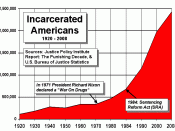The Federal Bureau of Investigation tracks four offenses murder, forcible rape, robbery, and aggravated assault in its Violent Crime Index. The juvenile arrest rate for each of these offenses has been declining steadily since the mid-1990s. The murder rate fell 70% from its 1993 peak through 2001 (Snyder, 2003).
Statistics: Research has shown that crimes committed by juveniles are more likely to be cleared by law enforcement than crimes committed by adults. The clearance data in the Crime in the United States series show that the proportion of violent crimes attributed to juveniles by law enforcement has declined in recent years. The proportion of violent crimes cleared by juvenile arrests grew from about 9% in the late 1980s to 14% in 1994 and then declined to 12% in 2001. (Snyder 2003).
Cleared Proportions: The juvenile proportion of cleared forcible rapes peaked in 1995 and then fell, with the 2001 proportion still above the levels of the late 1980s.
The juvenile proportion of robbery clearances also peaked in 1995 at 20% and fell substantially by 2001 to 14%, but was still above the levels of the late 1980s at 10%. The juvenile proportion of aggravated assault clearances was at 12% in 2001 and was slightly below its peak of 13% in 1994. This was still substantially above the levels of the late 1980s. The proportion of Property Crime Index offenses cleared by juvenile arrests in 2001 was below all but 2 years in the 1980s and 1990s. (Snyder 2003) Drug Offenses: The text highlights an overall increase in the rate of drug offenses as well as simple assaults amount juveniles. After review of arrest statistics, the finding were that law enforcement agencies made an estimated 202,500 arrests of young people for drug abuse violations in 2001. Of those 202,500 arrests a...


![Keeper Snyder [and] Comm. Stover (LOC)](https://s.writework.com/uploads/11/118154/keeper-snyder-and-comm-stover-loc-thumb.jpg)